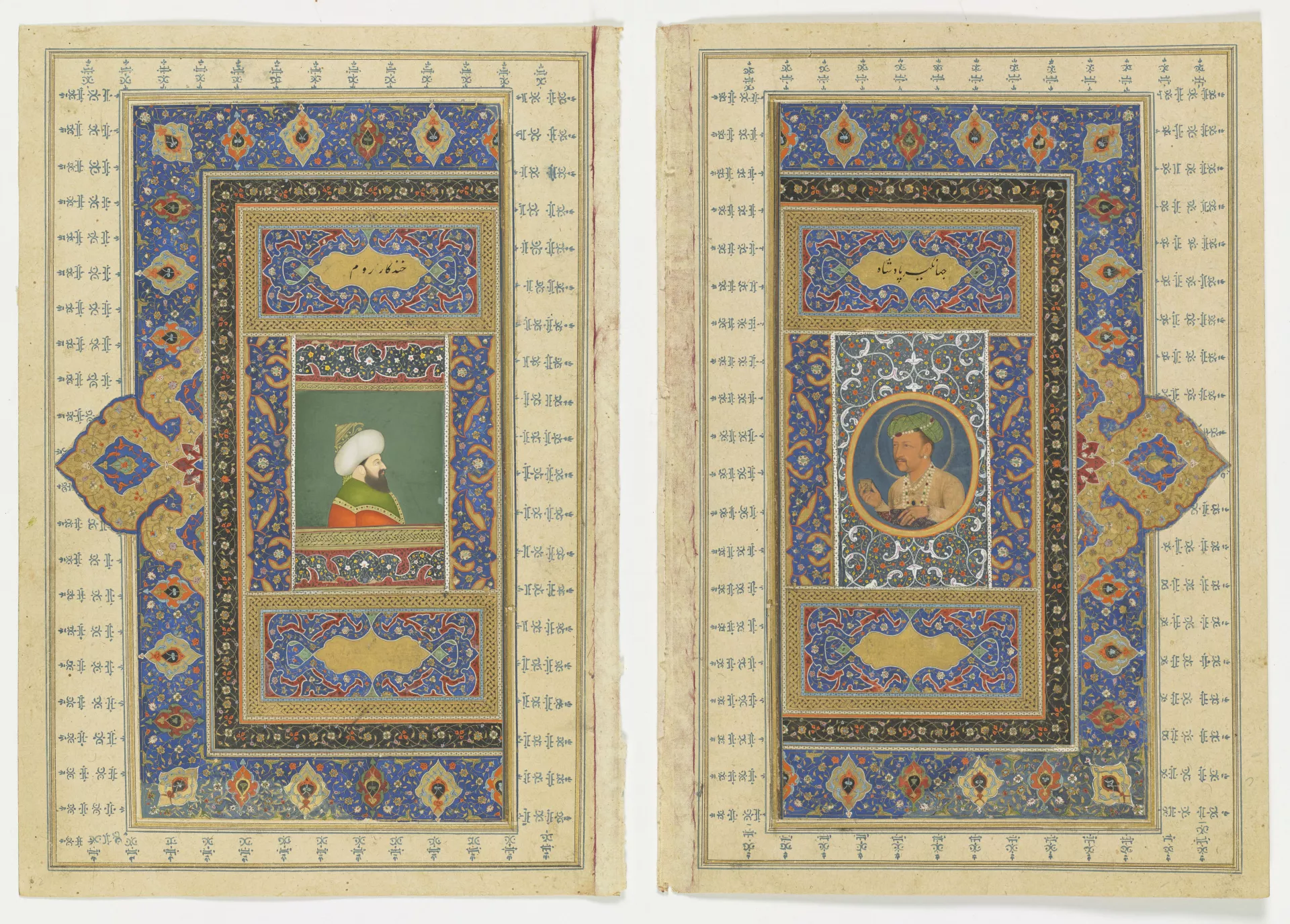
Eastern Encounters
Drawn from the Royal Library's collection of South Asian books and manuscripts
Illuminated frontispiece with bust portraits of the Mughal Emperor Jahangir and an Ottoman Sultan
Mughal, <i>c.</i>1620 and <i>c</i>.1740–50Fols 1v and 2r from an album of Mughal portraits and calligraphy (see cat. no. 15) | Composite album frontispiece: opaque watercolour including gold metallic paint and leaf with decorative incising and ink on multiple paper supports | 29.8 × 20.4 cm (folios); 4.5 × 4.0 cm (portrait on fol. 1v); 4.7 × 5.1 cm (portrait on fol. 2r) | RCINS 1005038.a and 1005038.b
Illuminated frontispieces in Mughal manuscripts and albums traditionally included a text preface. Overpainted damage at the lower edges demonstrates that the opening of this album (illustrated above) assembled in the mid-eighteenth century, has been taken from an earlier volume, the panels of calligraphy having been replaced with portraits of the Emperor Jahangir and an unnamed Ottoman sultan.
The portrait of Jahangir may originally have functioned as a miniature to be presented to and worn by a family member or close courtier. The Emperor is depicted in three-quarter profile with one hand resting on a carpet-draped balustrade. This framing device is a reference to the daily darshan (‘viewing’) ritual whereby the Emperor appeared to his subjects, assuring them of his good health and the stability of the state, and establishes a physical boundary between the viewer and the Emperor.[48] In his other hand Jahangir holds a small cup bearing an image of the Madonna and Child (see also cat. no. 14).[49] Jahangir’s greying hair suggests a date of c.1620 for the portrait. He wears a jama of the finest muslin (malmal) embroidered with a narrow jamdani pattern and adorned with fabulous jewels – an enormous sapphire, spinels, emeralds and pearls including a large pearl earring. Jahangir had both ears pierced in 1614 in imitation of the followers of the Sufi saint Khwaja Muin al-Din Chishti whom he credited with his recovery from a bout of illness. Later the same year the Emperor presented pearls to those members of his court who, by way of allegiance to him, had also pierced their ears.[50] The blue background is a later addition, as is the nimbus (shamsa) around his head, commonly used in Mughal portraiture to represent the farr-e izadi or ‘divine glory’ emitted by an emperor or holy figure.[51]
The comparatively unaccomplished eighteenth-century portrait of the Ottoman sultan is probably based on a monochrome print from which the brocade cap of his turban was evidently misinterpreted as a crown.[52]
jahangir padshah / Emperor Jahangir
khundkar-e rom / Emperor of Rom (Turkey)
[48] For the Mughal jharokha portrait, see Weekes 2017, esp. p. 49 and Losty 2013. See ‘Jahangir receives Prince Khurram,’ fol. 192v of the Royal Collection’s Padshahnama (RCIN 1005026.al) for an image of one of Jahangir’s courtiers wearing a miniature portrait of the Emperor attached to the front of his turban.
[49] There is a portrait of Jahangir holding a picture of Mary in the National Museum, New Delhi (Inv. 58.58/31).
[50] Jahangirnama, p. 161.
[51] For the origins of this see Soudavar 2003.
[52] For other paintings depicting Jahangir and an Ottoman sultan, see CBL In 07A.13 and Freer Sackler F1942.15. For another Mughal portrait of an Ottoman see Sotheby's 8 October 2008, lot no. 44.








